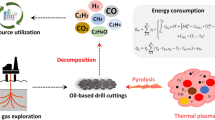Abstract
In this manuscript, the samples were collected from Weiyuan Investment Group. The basic properties of the oil-based drill cuttings and their pyrolysates were analyzed. The results show that the oil content of the oil-based drilling cuttings is 7.87%, and the average calorific value of pyrolysis gas is about 20,327 kJ m−3. In the component of gas, hydrogen accounts for 30.64% and CO2 accounts for 43.34%. The main components of pyrolytic oil are diesel fraction, of which the H/C ratio is 1.90 and the linear alkane is the main component, accounting for 65.65%. And the carbon number of the pyrolytic oil is mainly distributed in C12~C25. The pyrolytic products possess high value of recycling. The pyrolysis kinetics of oil-based drilling cuttings was studied by developing different kinetic models. Firstly, the mass loss of oil-based drilling cuttings can be divided into two stages. The first stage consists of the evaporation of water and the volatilization of small molecular organic compounds. The second stage is the main pyrolysis process which contents the breaking of carbon–carbon bond, and the thermogravimetric curve shifts to the high temperature region with the increasing of heating rate. The calculated results of different kinetic models show that the fitting degree of the two models is high. According to the calculated results using Friedman model, the pyrolysis stage of oil-based drilling cuttings increases from about 73 kJ mol−1 to about 109 kJ mol−1. According to the calculated results using DAEM model, the activation energy increased from about 63 kJ mol−1 to about 80 kJ mol−1. The results can help provide experimental data for industrial processing of oil-based drilling cuttings in Weiyuan Investment Group.







Similar content being viewed by others
References
de Almeida PC, Araújo OD, de Medeiros JL. Managing offshore drill cuttings waste for improved sustainability. J clean prod. 2017;165:143–56.
Huixin LI, Qingyuan ZHOU, Rong CHEN, et al. New environmental friendly and harmless treatment technology for oil-based drilling cuttings of shale gas well. Drill Prod Technol. 2021;44(02):90–3.
Xu N, Wang WX, Han PF, et al. Effects of ultrasound on oily sludge deoiling. J Hazard Mater. 2009;1711:914–7.
Rahele K, Mehrdad M, Somayeh R, et al. Selecting the best stabilization/solidification method for the treatment of oil-contaminated soils using simple and applied best-worst multi-criteria decision-making method. Environ Pollut. 2020;263:114447.
Perez PA, Reuben NO, Josiah MA. Diagnostic screening of organic contaminant level in solidified/stabilized pre-treated oil-based drill cuttings. Heliyon. 2019;5(10):02664.
FanY Y, Wang GC, Fu JH, et al. The remediation of waste drilling muds by a combined plant-microbe system. Pet Sci Technol. 2014;32(17):2086–92.
Yucheng LIU, Yuanyuan CHEN, Jingjing LIANG, et al. Experimental study on the treatment of oil based drilling cuttings by compound solvent extraction method. Appl Chem Ind. 2019;48(01):93–6.
Deming X, Peng L, Liu Pu, et al. Optimization test of vacuum pyrolysis process of shale gas oil-based drill cuttings. Environ Protect o foil Gas fields. 2020;30(06):17.
Xie Lei. Study on macro-thermogravimetry kinetics of pyrolysis of oil sludge. Dalian University of Technology, 2013:19–23.
Hao ZHOU, Gen bao WANG, Meng LI, et al. Investigation of pyrolysis characteristics of oil-contaminated drill cuttings. Chin J Environ Eng. 2017;11(12):6421–8.
Zivdar Z, Heidarzadeh N, Asadollahfardi G. Remediation of diesel-contaminated soil by low-temperature thermal desorption. Int J Environ Sci Technol. 2019;16:6113–24.
Zhang XY, Yao AG. Bench test on thermal desorption dispose of oily cuttings. J Petrol Explor Prod Technol. 2019;9(1):663–8.
Meigui F, Wei W, Weiguo Ma, et al. Present situation and prospect of thermal desorption technology for oil-based drill cuttings. Explor Eng. 2019;46(03):7–12.
Robinson JP, Kingman SW, Snape CE, Barranco R, et al. Remediation of oil-contaminated drill cuttings using continuous microwave heating. Chem Eng J. 2009;152(2):458.
Feihou Y, Dongwqi S, Pengyou H, et al. The study on pyrolysis of oil-based drilling cuttings by microwave and electric heating. J Environ Manag. 2018;228:312–8.
Li Tong. Catalytic pyrolysis and kinetics study of oil-based cuttings for shale gas drilling. Chongqing University, 2018.
Shuqing Y, Shuqing Z, Shuqing W, et al. Pyrolysis kinetic analysis of oily sludge in Lingang. CIESC J. 2015;2015:327–33.
Wang Q, Zhao W, Liu H, et al. Interactions and kinetic analysis of oil shale semi-coke with cornstalk during co-combustion. Appl Energy. 2011;88(6):2080–7.
Shie JL, Chang CY, Lin JP, Wu CH, Lee DJ. Resources recovery of oil sludge by pyrolysis: kinetics study. J Chem Technol Biotechnol. 2000;75(6):443–50.
Vand V. A theory of the irreversible electrical resistance changes of metallic films evaporated in vacuum. Proc Phys Soc. 2002;55(3):222.
Hongyan W, Yuyan Z, Dexin Ji, et al. Co-combustion of Oil sludge char and brown coal: characteristics and kinetics. CIESC J. 2020;71(02):755–65.
Author information
Authors and Affiliations
Corresponding author
Additional information
Publisher's Note
Springer Nature remains neutral with regard to jurisdictional claims in published maps and institutional affiliations.
Rights and permissions
Springer Nature or its licensor (e.g. a society or other partner) holds exclusive rights to this article under a publishing agreement with the author(s) or other rightsholder(s); author self-archiving of the accepted manuscript version of this article is solely governed by the terms of such publishing agreement and applicable law.
About this article
Cite this article
Ma, Y., Shao, F., Fu, S. et al. Study of pyrolysis characteristics and kinetics of oil-based drill cuttings. J Therm Anal Calorim 148, 9561–9570 (2023). https://doi.org/10.1007/s10973-023-12318-7
Received:
Accepted:
Published:
Issue Date:
DOI: https://doi.org/10.1007/s10973-023-12318-7




